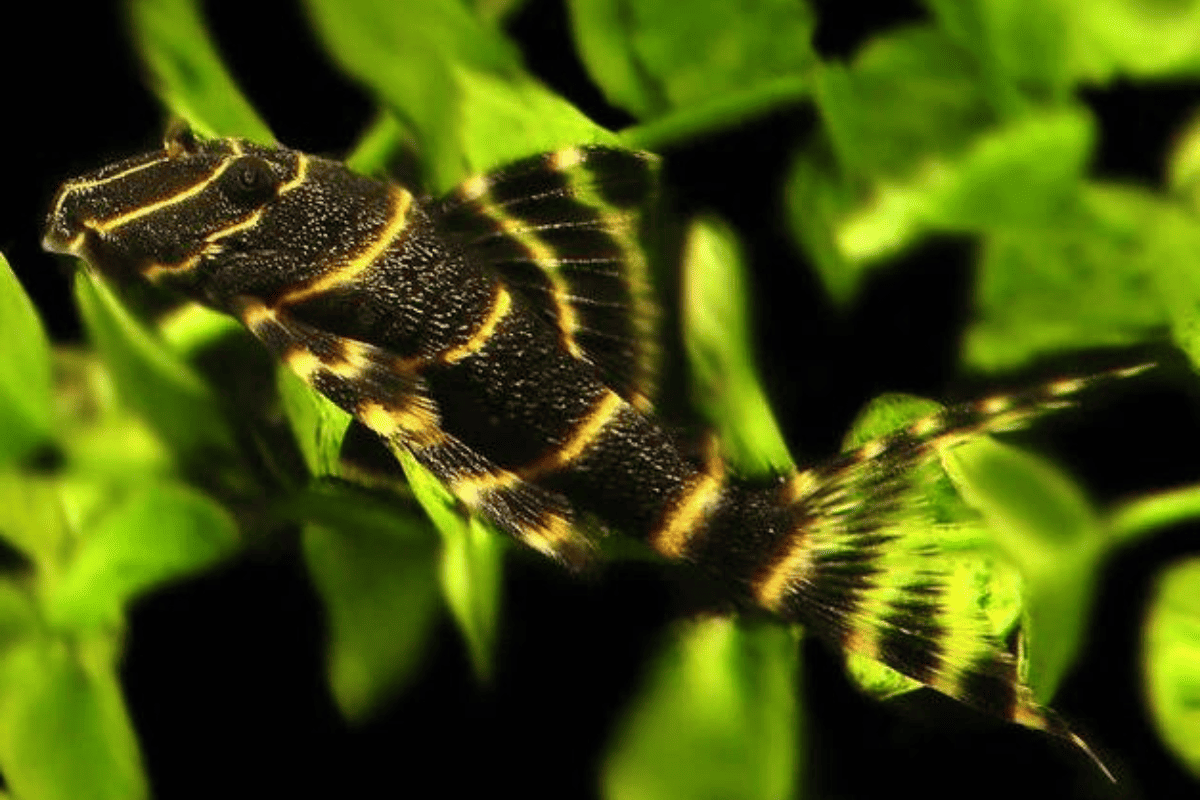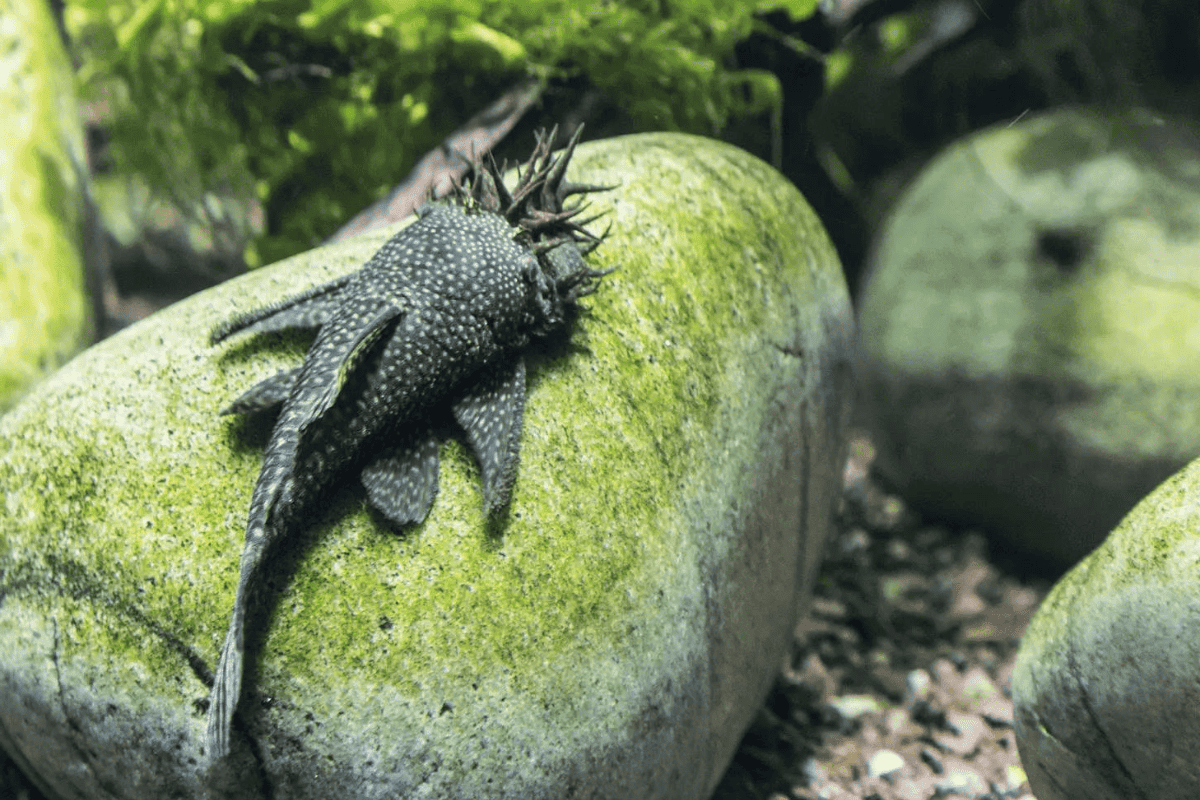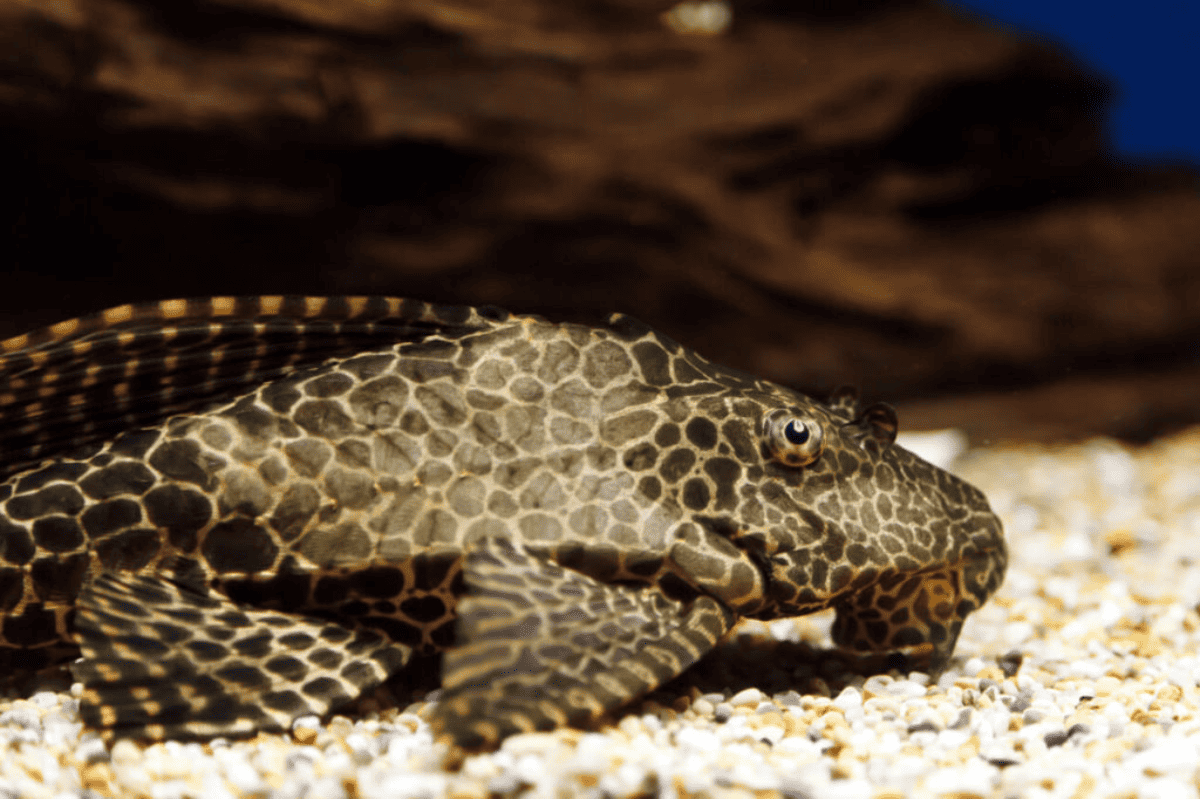If you are new to Plecos, the first question that comes to mind is, what water parameters do they require?
What is the best temperature for them, and what about pH and water hardness? And what should you do about the ammonia, nitrate, and nitrites? Are they sensitive to those?
I will discuss all of these aspects in this article, so you will have all the information you need. Let’s dive right into it.
Also Read: Pleco Fish Tank Setup

Best Water Parameters for Plecos
Before we begin, here’s a concise table showing the recommended temperature, pH, and water hardness for the most common pleco species kept in home aquariums:
| Pleco Species | Temperature [°F (°C)] | pH | Water Hardness (dGH) |
| Common Pleco | 73-82 (23-28) | 6.5-7.5 | 5-19 |
| Bristlenose | 72-79 (22-26) | 6.5-7.5 | 5-20 |
| Clown Pleco | 73-82 (23-28) | 6.8-7.6 | 6-15 |
| Zebra Pleco | 79-86 (26-30) | 6.5-7.0 | 2-6 |
| Rubber Lip | 72-78 (22-26) | 6.5-8.0 | 5-15 |
| Royal Pleco | 77-82 (25-28) | 6.6-7.5 | 6-20 |
| Gold Nugget | 77-86 (25-30) | 6.5-7.5 | 5-15 |
| Vampire Pleco | 73-79 (23-26) | 6.6-7.8 | 6-20 |
| Snowball Pleco | 74-81 (23-27) | 6.5-7.2 | 5-12 |
| Blue Phantom | 73-87 (23-31) | 6.5-7.8 | 6-10 |
| Galaxy Pleco | 76-82 (24-28) | 6.7-7.5 | 5-15 |
| Butterfly Pleco | 72-82 (22-28) | 6.5-7.5 | 5-20 |
| Flash Pleco | 72-80 (22-27) | 6.5-7.5 | 4-10 |
| Spotted Pleco | 74-80 (23-27) | 6.6-7.4 | 5-18 |
| King Tiger | 73-79 (23-26) | 6.5-7.0 | 6-15 |
| Rhino Pleco | 75-82 (24-28) | 6.7-7.5 | 5-20 |
| Panaque Pleco | 76-83 (24-28) | 6.6-7.6 | 5-18 |
| Peppermint Pleco | 73-80 (23-27) | 6.5-7.5 | 6-20 |
| Medusa Pleco | 72-78 (22-26) | 6.5-7.8 | 4-12 |
| Sunshine Pleco | 75-82 (24-28) | 6.5-7.2 | 6-15 |
Optimal Temperature for Plecos
Plecos thrive at specific temperatures. Generally, most species of Plecos are comfortable in temperatures between 74°F to 80°F (23°C to 27°C).
If the temperature in your tank is out of range, here’s how to change it:
1. How to Raise the Temperature in a Pleco Tank
Sometimes, we might need to warm things up a bit, especially during those chilly months.
- Heaters: Invest in a quality adjustable heater. For a 20-gallon tank with Plecos, a 50-watt heater typically does the trick. I personally picked the Fluval E300 Advanced Heater (link to Amazon).
- Positioning: Place that tank thoughtfully. Windows or drafty areas can cool things down. A cozy corner, away from direct AC or window drafts, helps Plecos stay warm.
- Monitor with Thermometers: Use a reliable digital thermometer. They’re more accurate than stick-on types. Plecos like it between 74-80°F (23-27°C); so, keep an eye on that!
- Insulation: Consider tank insulators or covers. They can keep warmth in, especially during cold nights. Even a simple polystyrene board behind the tank can make a difference for your Plecos.
Also Read: Do Plecos Need A Heater?

2. How to Lower the Temperature in a Pleco Tank
On the flip side, sometimes it gets too hot, and we’ve got to cool things down for our Plecos.
- Positioning: Move the tank away from direct sunlight. Plecos aren’t sunbathers; a spot shaded from direct sun rays keeps their water cooler.
- Fans and Coolers: Invest in aquarium fans or chillers. For a quick fix, a small clip-on fan blowing across the water surface can reduce the temperature by a few degrees.
- Water Changes: Implement cool water changes. Replacing about 10-15% of the tank water with cooler, dechlorinated water can help drop the temp without stressing your Plecos.
- Limit Lighting: Reduce light usage if you’ve got powerful tank lights. These lights can produce heat, so for the Plecos’ sake, limit the usage during hotter days.
Also Read: Plecos Temperature Guide
Ideal pH Levels for Plecos
The ideal pH level for Plecos typically ranges from 6.5 to 7.5. Maintaining pH within this range helps ensure the health and well-being of these fish in captivity.
If the pH in your tank doesn’t fall within that range, here’s how you can change it:
1. How to Increase the pH for Plecos
Elevating pH is sometimes necessary for specific Pleco species or certain water conditions. Here’s what you should do:
- Limestone and Crushed Coral: Add 1-2 lbs per 10 gallons. As they dissolve, they release minerals that harden the water and gently raise the pH, ideal for Plecos.
- Baking Soda: A pinch per 10 gallons can help. Dissolve it in some tank water before adding. Always test the pH after to ensure you don’t overshoot the desired level for Plecos.
- pH Up Products: Commercial solutions are available. Dose as per instructions, typically a few drops per gallon, but keep an eye on pH levels for Plecos’ safety. The API PROPER pH 7.0 (link to Amazon) saved me many times.
- Aeration: Increasing aeration can subtly elevate pH. More oxygen exchange can reduce CO2 levels, leading to a slight pH rise; ensure your Plecos are comfortable with the current.

2. How to Decrease the pH for Plecos
If your water is too alkaline for your Plecos, bringing it down is crucial. Here’s how to do that properly:
- Peat Moss: Place in a filter bag; use about 1 cup per 10 gallons. As it decomposes, it releases tannins, gently reducing pH and mimicking Plecos’ natural habitats.
- Driftwood: Adding a sizable piece can help. As it breaks down, it releases tannins that acidify the water, creating an environment Plecos appreciate.
- pH Down Products: Commercial solutions exist for this too. Typically, a few drops per gallon are sufficient, but monitor pH levels closely for Plecos.
- RO Water: Using reverse osmosis water for water changes can decrease pH. Blend it with tap water to reach the desired pH for your Plecos.
Also Read: Best pH For Plecos
Recommended Water Hardness for Plecos
Plecos thrive in aquariums with water hardness levels between 5 to 15 dGH (degrees of General Hardness) or approximately 90 to 268 ppm (parts per million).
If the water hardness in your tank is out of range, here’s how to adjust it:
1. How to Increase the Water Hardness
Plecos, like many other fish, sometimes need increased hardness to maintain good health:
- Limestone or Coral: Add crushed coral or limestone to your aquarium. About a handful for a 20-gallon tank can significantly alter the hardness, but always monitor with a test kit.
- Baking Soda: Mix 1 teaspoon of baking soda with some aquarium water, then add to a 50-gallon tank. This method requires close monitoring to avoid rapid changes.
- Commercial Hardness Increasers: Available at pet stores. Follow manufacturer instructions, typically adding a capful for every 10 gallons.
- Epsom Salts: Add 1 tablespoon of Epsom salts per 5 gallons of tank water. This raises general hardness by providing magnesium.

2. How to Soften the Water for Plecos
For Plecos originating from soft water habitats, here’s how you can make your aquarium water softer:
- Peat Moss: Place peat moss in your filter or as a substrate. For a 40-gallon tank, a fist-sized amount is sufficient. This releases tannins that soften the water.
- RO Water: Use reverse osmosis (RO) water. Mixing RO water with tap water can help reduce hardness. For example, a 50/50 mix can halve your current hardness levels.
- Driftwood: Add driftwood to the aquarium. Not only does it provide hiding spots for Plecos, but tannins released can soften the water.
- Water Softening Pillows: These are resin-filled pillows used in filters. One pillow is typically effective for a 20-gallon tank for about a month. My recommendation: API WATER SOFTENER PILLOW (link to Amazon).
Also Read: Best Water Hardness For Plecos
Ammonia, Nitrate, and Nitrite Levels for Plecos
Plecos should be kept in water where ammonia and nitrite levels are almost undetectable, and nitrate levels are kept low.
- Ammonia: Ideally, the ammonia level for Plecos should be 0 ppm. Elevated levels can burn their gills and skin. For example, even 0.25 ppm can be harmful, causing stress and potentially death if prolonged.
- Nitrite: Plecos, like other fish, are sensitive to nitrite. The ideal nitrite level is also 0 ppm. A reading of even 0.5 ppm can be detrimental, leading to reduced oxygen carrying capacity in their blood.
- Nitrate: While more tolerant to nitrates, Plecos thrive when levels are below 20 ppm. Regular water changes and live plants, like Java Fern, can help maintain low nitrate levels, ensuring your Plecos are both happy and healthy.

Are Plecos Sensitive to Water Changes?
Yes, Plecos are sensitive to rapid and significant water changes. Like many fish, they thrive best in stable conditions.
Sudden alterations in water parameters can cause them undue stress, which can negatively impact their health.
- Temperature Fluctuations: Plecos are especially sensitive to sudden temperature changes. A difference of more than 2°F in a short time span can stress Plecos, making them susceptible to diseases.
- pH Swings: Rapid changes in pH can affect the Pleco’s metabolism. For instance, a sudden jump from a pH of 6.5 to 7.5 within hours can be extremely harmful.
- Toxin Build-up: If you’ve delayed water changes, toxins can build up. A sudden large water change, even if meant to be helpful, can shock Plecos due to abrupt shifts in these toxin levels.
- Electrolyte Imbalance: Plecos require certain minerals in the water for osmoregulation. A significant water change using purified or distilled water may deplete these essential minerals, disrupting their internal balance.
- Recommended Water Change: For the well-being of Plecos, aim to change 20-25% of the tank water weekly. This approach balances out toxins and maintains stable conditions, avoiding drastic changes that could stress your Plecos.
Also Read: Pleco Fish Tank Size

Conclusions
For those of you who are just skimming through, here’s a short recap:
- Maintain Pleco tanks at 74-80°F for optimal temperature conditions, adjusting as needed with reliable heaters.
- Keep pH levels within the range of 6.5-7.5 to provide a stable and healthy aquatic habitat for Plecos.
- Ensure water hardness falls between 5-15 dGH by incorporating natural or controlled methods for ideal Pleco care.
- Implement diligent monitoring and management of ammonia, nitrite, and nitrate levels to promote a thriving Pleco environment.
- To prevent stress and maintain consistent conditions, avoid sudden and drastic changes in water parameters, prioritizing gradual adjustments.

